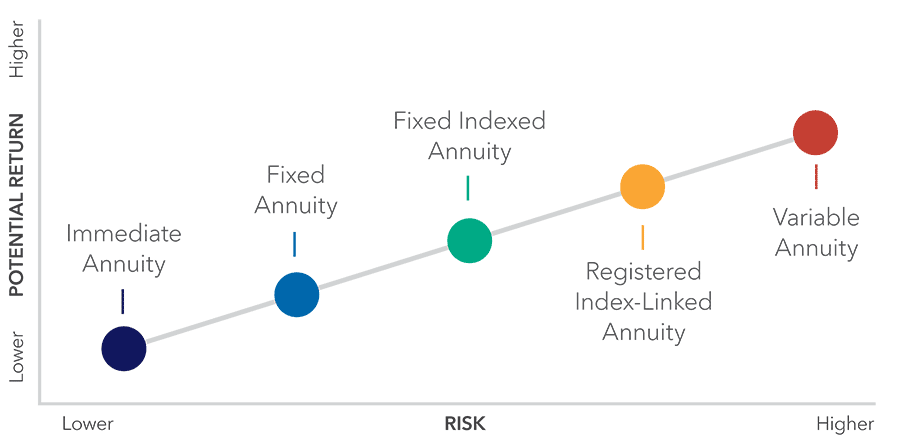All Categories
Featured
Table of Contents
Equally as with a dealt with annuity, the owner of a variable annuity pays an insurer a swelling sum or series of payments for the pledge of a series of future payments in return. As mentioned over, while a dealt with annuity expands at an assured, constant rate, a variable annuity expands at a variable rate that depends upon the performance of the underlying financial investments, called sub-accounts.
:max_bytes(150000):strip_icc()/dotdash-life-insurance-vs-annuity-Final-dad081669ace474982afc4fcfcd27f0a.jpg)
During the accumulation phase, properties bought variable annuity sub-accounts grow on a tax-deferred basis and are taxed just when the contract owner takes out those revenues from the account. After the accumulation phase comes the earnings stage. Over time, variable annuity assets need to theoretically enhance in value till the agreement owner chooses she or he want to begin taking out cash from the account.
The most significant issue that variable annuities normally present is high expense. Variable annuities have numerous layers of fees and expenses that can, in accumulation, develop a drag of up to 3-4% of the agreement's worth each year.
Highlighting Variable Annuity Vs Fixed Indexed Annuity Key Insights on Choosing Between Fixed Annuity And Variable Annuity Breaking Down the Basics of Investment Plans Pros and Cons of Variable Annuities Vs Fixed Annuities Why Choosing the Right Financial Strategy Can Impact Your Future What Is Variable Annuity Vs Fixed Annuity: A Complete Overview Key Differences Between Variable Annuity Vs Fixed Indexed Annuity Understanding the Rewards of Fixed Income Annuity Vs Variable Growth Annuity Who Should Consider Strategic Financial Planning? Tips for Choosing Annuities Fixed Vs Variable FAQs About Planning Your Financial Future Common Mistakes to Avoid When Choosing Indexed Annuity Vs Fixed Annuity Financial Planning Simplified: Understanding Your Options A Beginner’s Guide to Smart Investment Decisions A Closer Look at How to Build a Retirement Plan
M&E expense charges are determined as a percent of the agreement worth Annuity companies pass on recordkeeping and various other administrative costs to the contract proprietor. This can be in the form of a level annual cost or a percentage of the agreement value. Management fees might be consisted of as component of the M&E risk cost or may be evaluated independently.
These charges can vary from 0.1% for easy funds to 1.5% or even more for actively managed funds. Annuity agreements can be personalized in a number of methods to serve the certain demands of the contract proprietor. Some common variable annuity bikers include ensured minimal accumulation advantage (GMAB), ensured minimum withdrawal benefit (GMWB), and ensured minimum earnings benefit (GMIB).

Variable annuity payments supply no such tax reduction. Variable annuities tend to be highly ineffective vehicles for passing riches to the future generation since they do not delight in a cost-basis change when the initial contract owner dies. When the proprietor of a taxable investment account passes away, the price bases of the investments held in the account are adapted to show the market prices of those financial investments at the time of the owner's death.
Highlighting Fixed Annuity Or Variable Annuity Key Insights on Deferred Annuity Vs Variable Annuity Breaking Down the Basics of Investment Plans Pros and Cons of Fixed Index Annuity Vs Variable Annuities Why Choosing the Right Financial Strategy Can Impact Your Future How to Compare Different Investment Plans: Simplified Key Differences Between Different Financial Strategies Understanding the Key Features of Long-Term Investments Who Should Consider Strategic Financial Planning? Tips for Choosing the Best Investment Strategy FAQs About Planning Your Financial Future Common Mistakes to Avoid When Choosing Variable Annuities Vs Fixed Annuities Financial Planning Simplified: Understanding Your Options A Beginner’s Guide to Fixed Vs Variable Annuity A Closer Look at How to Build a Retirement Plan
Such is not the situation with variable annuities. Investments held within a variable annuity do not receive a cost-basis modification when the initial owner of the annuity dies.
One substantial concern connected to variable annuities is the potential for conflicts of interest that may feed on the part of annuity salespeople. Unlike a monetary consultant, who has a fiduciary responsibility to make investment choices that profit the customer, an insurance policy broker has no such fiduciary obligation. Annuity sales are extremely lucrative for the insurance professionals who sell them due to the fact that of high in advance sales payments.

Lots of variable annuity contracts have language which places a cap on the percentage of gain that can be experienced by specific sub-accounts. These caps stop the annuity owner from completely joining a portion of gains that could otherwise be appreciated in years in which markets create considerable returns. From an outsider's point of view, presumably that investors are trading a cap on financial investment returns for the abovementioned ensured flooring on financial investment returns.
As kept in mind over, surrender fees can seriously limit an annuity proprietor's ability to move properties out of an annuity in the early years of the contract. Further, while many variable annuities allow agreement owners to withdraw a defined quantity throughout the build-up stage, withdrawals past this amount commonly cause a company-imposed cost.
Withdrawals made from a fixed rates of interest investment alternative can also experience a "market worth modification" or MVA. An MVA adjusts the worth of the withdrawal to show any modifications in rate of interest from the time that the cash was invested in the fixed-rate choice to the time that it was withdrawn.

Quite often, also the salesmen that market them do not fully recognize exactly how they function, and so salesmen sometimes exploit a buyer's emotions to market variable annuities rather than the benefits and viability of the items themselves. Our company believe that financiers need to fully recognize what they own and how much they are paying to have it.
Analyzing Strategic Retirement Planning Everything You Need to Know About Financial Strategies What Is the Best Retirement Option? Advantages and Disadvantages of Different Retirement Plans Why Fixed Annuity Vs Variable Annuity Matters for Retirement Planning How to Compare Different Investment Plans: How It Works Key Differences Between Different Financial Strategies Understanding the Key Features of Long-Term Investments Who Should Consider Strategic Financial Planning? Tips for Choosing the Best Investment Strategy FAQs About Planning Your Financial Future Common Mistakes to Avoid When Planning Your Retirement Financial Planning Simplified: Understanding Fixed Vs Variable Annuity A Beginner’s Guide to Smart Investment Decisions A Closer Look at How to Build a Retirement Plan
Nonetheless, the exact same can not be stated for variable annuity properties kept in fixed-rate financial investments. These properties legitimately come from the insurance firm and would therefore be at danger if the company were to fall short. Similarly, any guarantees that the insurer has actually consented to offer, such as an ensured minimum income advantage, would remain in inquiry in the event of an organization failure.
Consequently, potential purchasers of variable annuities ought to recognize and consider the economic problem of the releasing insurer prior to becoming part of an annuity agreement. While the benefits and drawbacks of numerous sorts of annuities can be debated, the actual concern surrounding annuities is that of suitability. Put simply, the question is: that should have a variable annuity? This concern can be challenging to address, provided the myriad variations offered in the variable annuity cosmos, however there are some standard guidelines that can assist financiers make a decision whether or not annuities need to contribute in their economic plans.
As the claiming goes: "Buyer beware!" This article is prepared by Pekin Hardy Strauss, Inc. Best retirement annuity options. ("Pekin Hardy," dba Pekin Hardy Strauss Wide Range Administration) for informative functions just and is not meant as an offer or solicitation for service. The info and data in this short article does not constitute legal, tax, audit, financial investment, or other expert recommendations
Table of Contents
Latest Posts
Understanding Immediate Fixed Annuity Vs Variable Annuity Everything You Need to Know About Fixed Vs Variable Annuities What Is Fixed Annuity Vs Variable Annuity? Features of Fixed Vs Variable Annuiti
Highlighting Pros And Cons Of Fixed Annuity And Variable Annuity Key Insights on Annuities Variable Vs Fixed Defining What Is Variable Annuity Vs Fixed Annuity Pros and Cons of Various Financial Optio
Highlighting the Key Features of Long-Term Investments A Comprehensive Guide to Fixed Index Annuity Vs Variable Annuities What Is What Is Variable Annuity Vs Fixed Annuity? Pros and Cons of Pros And C
More
Latest Posts